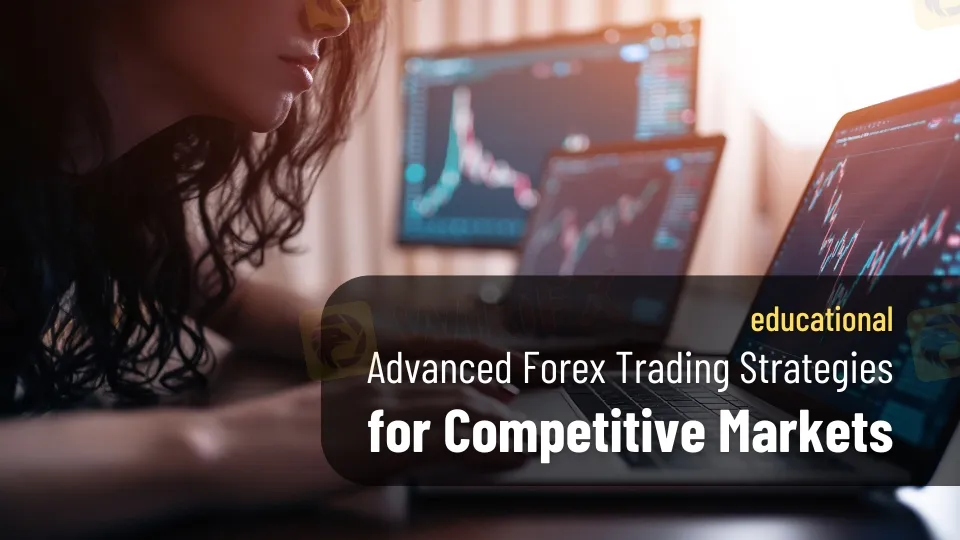简体中文
繁體中文
English
Pусский
日本語
ภาษาไทย
Tiếng Việt
Bahasa Indonesia
Español
हिन्दी
Filippiiniläinen
Français
Deutsch
Português
Türkçe
한국어
العربية
Advanced Forex Trading Strategies for Competitive Markets
Abstract:The foreign exchange (forex) market is the largest and most liquid financial market in the world, with trillions of dollars traded daily. For traders, this presents both opportunities and challenges. While the potential for profit is significant, the competitive nature of the market demands a sophisticated approach. To thrive in this environment, traders must adopt advanced strategies that go beyond the basics. This article explores key techniques, including understanding market trends, mastering technical indicators, trading breakouts and reversals, and building a robust trading plan for consistency.

Advanced Forex Trading Strategies for Competitive Markets
The foreign exchange (forex) market is the largest and most liquid financial market in the world, with trillions of dollars traded daily. For traders, this presents both opportunities and challenges. While the potential for profit is significant, the competitive nature of the market demands a sophisticated approach. To thrive in this environment, traders must adopt advanced strategies that go beyond the basics. This article explores key techniques, including understanding market trends, mastering technical indicators, trading breakouts and reversals, and building a robust trading plan for consistency.
Understanding Market Trends and Price Action Analysis
At the heart of successful forex trading lies the ability to understand and interpret market trends. A trend is the general direction in which a currency pair is moving, and identifying it early can provide a significant edge. Trends can be upward (bullish), downward (bearish), or sideways (ranging).
Price action analysis is a powerful tool for understanding market trends. It involves studying historical price movements to predict future behavior. Unlike indicators that rely on mathematical calculations, price action focuses on raw price data, such as candlestick patterns, support and resistance levels, and chart formations.
For example, a series of higher highs and higher lows typically indicates an uptrend, while lower highs and lower lows suggest a downtrend. Traders can use this information to align their trades with the prevailing trend, increasing the likelihood of success. Additionally, understanding key levels of support and resistance can help traders identify potential entry and exit points.

Mastering Technical Indicators for Forex Trading
While price action provides valuable insights, technical indicators offer a complementary perspective. These tools use mathematical calculations based on price, volume, or open interest to provide additional context about market conditions.
Some of the most widely used technical indicators in forex trading include:
1. Moving Averages (MA): These indicators smooth out price data to identify trends. The Simple Moving Average (SMA) and Exponential Moving Average (EMA) are popular choices. Traders often use crossovers, such as when a short-term MA crosses above a long-term MA, to signal potential buy opportunities.
2. Relative Strength Index (RSI): This momentum oscillator measures the speed and change of price movements. An RSI reading above 70 typically indicates overbought conditions, while a reading below 30 suggests oversold conditions.
3. Bollinger Bands: These bands consist of a moving average and two standard deviations above and below it. They help traders identify volatility and potential breakout points.
4. Fibonacci Retracement: This tool is based on the idea that markets will retrace a predictable portion of a move before continuing in the original direction. Traders use Fibonacci levels to identify potential support and resistance areas.
Mastering these indicators requires practice and a deep understanding of their strengths and limitations. Combining multiple indicators can provide a more comprehensive view of the market, but it's essential to avoid overloading charts with too many tools, as this can lead to analysis paralysis.
Trading Breakouts and Reversals Effectively
Breakouts and reversals are two of the most common trading scenarios in the forex market. A breakout occurs when the price moves beyond a defined support or resistance level, often signaling the start of a new trend. A reversal, on the other hand, occurs when the price changes direction, marking the end of a trend.
Trading Breakouts:
To trade breakouts effectively, traders must first identify key levels of support and resistance. These levels can be based on historical price data, trendlines, or technical indicators. Once a breakout occurs, traders can enter a position in the direction of the breakout, often using a stop-loss order to manage risk.
For example, if the price of EUR/USD breaks above a significant resistance level, a trader might go long, anticipating further upward movement. It's crucial to confirm the breakout with volume or momentum indicators, as false breakouts are common in the forex market.
Trading Reversals:
Reversals can be more challenging to trade, as they require identifying the end of a trend before it becomes apparent. Traders often use technical indicators like the RSI or MACD to spot potential reversals. Additionally, candlestick patterns, such as the engulfing pattern or doji, can provide early signals of a trend change.
For instance, if the price of GBP/USD has been in a strong uptrend but shows signs of weakening momentum, a trader might look for confirmation of a reversal before entering a short position.
Building a Forex Trading Plan for Consistency

Consistency is the hallmark of successful forex traders. To achieve this, traders must develop a comprehensive trading plan that outlines their strategy, risk management rules, and psychological approach.
Key Components of a Trading Plan:
1. Strategy: Define the trading strategies you will use, such as trend following, breakout trading, or scalping. Specify the timeframes you will trade and the indicators you will rely on.
2. Risk Management: Determine how much capital you are willing to risk on each trade. A common rule is to risk no more than 1-2% of your trading account on a single trade. Set stop-loss and take-profit levels to manage risk and lock in profits.
3. Entry and Exit Rules: Establish clear criteria for entering and exiting trades. This could include specific technical indicators, price levels, or candlestick patterns.
4. Psychological Discipline: Trading can be emotionally challenging, especially during periods of loss. Develop a mindset that allows you to stick to your plan and avoid impulsive decisions.
5. Review and Adaptation: Regularly review your trading performance to identify strengths and weaknesses. Adapt your plan as needed to reflect changing market conditions or personal growth as a trader.
By following a well-defined trading plan, traders can reduce emotional decision-making and increase their chances of long-term success.
Conclusion
The forex market's competitive nature demands a disciplined and strategic approach. By understanding market trends, mastering technical indicators, effectively trading breakouts and reversals, and building a robust trading plan, traders can navigate the complexities of the forex market with confidence. While no strategy guarantees success, combining these advanced techniques with consistent practice and continuous learning can significantly enhance your trading performance.
Whether you're a seasoned trader or just starting, these strategies provide a solid foundation for achieving your financial goals in the dynamic world of forex trading.

Disclaimer:
The views in this article only represent the author's personal views, and do not constitute investment advice on this platform. This platform does not guarantee the accuracy, completeness and timeliness of the information in the article, and will not be liable for any loss caused by the use of or reliance on the information in the article.
Read more

Fidelity Exposed: Traders Complain About Withdrawal Denials, Frozen Accounts & Platform Glitches
Does Fidelity Investments prevent you from accessing funds despite numerous assurances on your requests? Do you witness an account freeze by the US-based forex broker every time you request withdrawal access? Do you struggle with an unstable trading platform here? Is the slow Fidelity customer service making you face forced liquidation? These issues haunt traders, with many of them voicing their frustration on several broker review platforms such as WikiFX. In this Fidelity review article, we have shared quite a few complaints for you to look at. Read on!

Exposing The Trading Pit: Traders Blame the Broker for Unfair Withdrawal Denials & Account Blocks
Did you receive contradictory emails from The Trading Pit, with one approving payout and another rejecting it, citing trading rule violations? Did you purchase multiple trading accounts but receive a payout on only one of them? Did The Trading Pit prop firm refund you for the remaining accounts without clear reasoning? Did you face account bans despite using limited margins and keeping investment risks to a minimum? These are some raging complaints found under The Trading Pit review. We will share some of these complaints in this article. Take a look.

M&G Review: Traders Report Fund Scams, Misleading Market Info & False Return Promises
Applying for multiple withdrawals at M&G Investments but not getting it into your bank account? Do you see the uncredited withdrawal funds out of your forex trading account on the M&G login? Does the customer support service fail to address this trading issue? Does the misleading market information provided on this forex broker’s trading platform make you lose all your invested capital? Were you lured into investing under the promise of guaranteed forex returns? These issues have become highly common for traders at M&G Investments. In this M&G review article, we have echoed investor sentiments through their complaint screenshots. Take a look!

INZO Broker MT5 Review 2025: A Trader's Guide to Features, Fees and Risks
INZO is a foreign exchange (Forex) and Contracts for Difference (CFD) brokerage company that started working in 2021. The company is registered in Saint Vincent and the Grenadines and regulated offshore. It focuses on serving clients around the world by giving them access to popular trading platforms, especially MetaTrader 5 (MT5) and cTrader. The company offers different types of trading instruments, from currency pairs to cryptocurrencies. It aims to help both new and experienced traders. Read on to know more about it.
WikiFX Broker
Latest News
2 Malaysians Arrested in $1 Million Gold Scam Impersonating Singapore Officials
Exness Broker Expands in South Africa with Cape Town Hub
Fraud Mastermind Zhimin Qian Sentenced to 11 Years for $6.6 Billion Bitcoin Ponzi Scheme
Is FXPesa Regulated? Real User Reviews & Regulation Check
Almahfaza Broker – 2025 Review: Safe or Scam?
Uniglobe Markets Review 2025: A Complete Guide to an Unregulated Broker
INZO Broker No Deposit Bonus: A 2025 Deep Dive into Its Offers and Risks
Global Guide to Finding Forex IBs/Brokers — Share Your Pick and Win Big!
Trump tariffs are helping drive U.S. beef prices to new highs
BTSE Review: Ponzi Scam, KYC Verification Hassles & Account Blocks Hit Traders Hard
Currency Calculator



